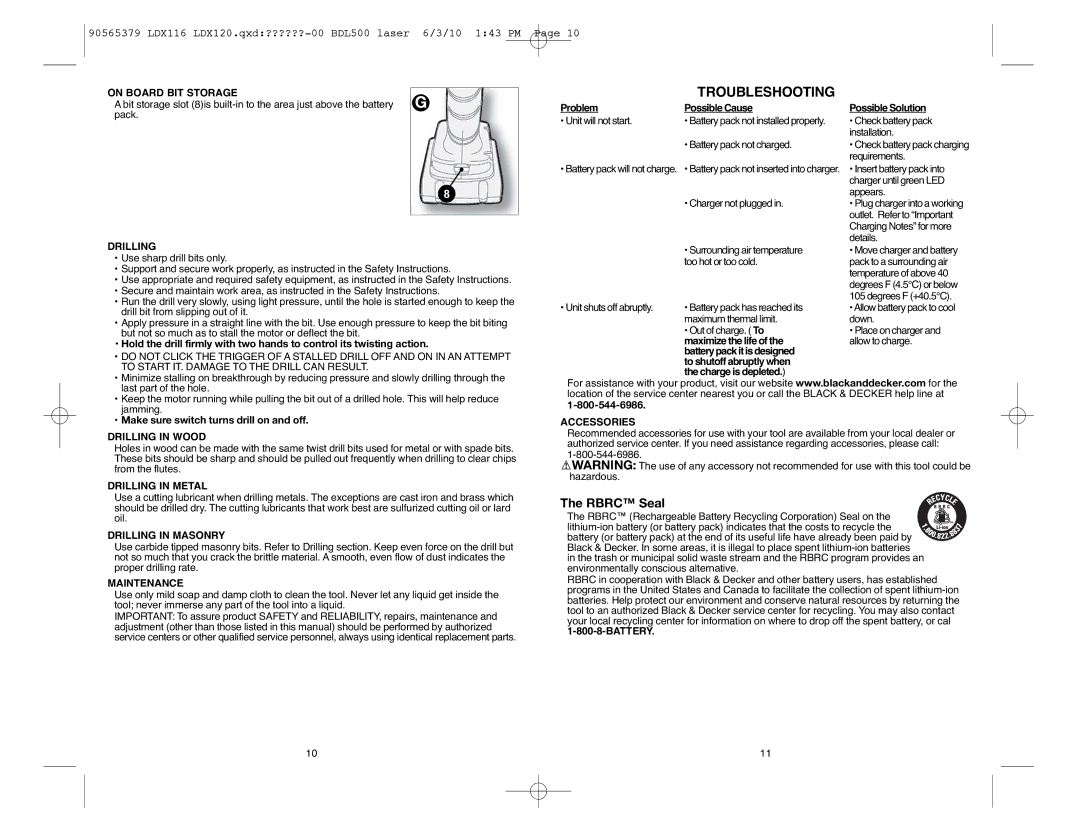
90565379 LDX116
ON BOARD BIT STORAGE
A bit storage slot (8)is
![]() 8
8
DRILLING
•Use sharp drill bits only.
•Support and secure work properly, as instructed in the Safety Instructions.
•Use appropriate and required safety equipment, as instructed in the Safety Instructions.
•Secure and maintain work area, as instructed in the Safety Instructions.
•Run the drill very slowly, using light pressure, until the hole is started enough to keep the drill bit from slipping out of it.
•Apply pressure in a straight line with the bit. Use enough pressure to keep the bit biting but not so much as to stall the motor or deflect the bit.
•Hold the drill firmly with two hands to control its twisting action.
•DO NOT CLICK THE TRIGGER OF A STALLED DRILL OFF AND ON IN AN ATTEMPT TO START IT. DAMAGE TO THE DRILL CAN RESULT.
•Minimize stalling on breakthrough by reducing pressure and slowly drilling through the last part of the hole.
•Keep the motor running while pulling the bit out of a drilled hole. This will help reduce jamming.
•Make sure switch turns drill on and off.
DRILLING IN WOOD
Holes in wood can be made with the same twist drill bits used for metal or with spade bits. These bits should be sharp and should be pulled out frequently when drilling to clear chips from the flutes.
DRILLING IN METAL
Use a cutting lubricant when drilling metals. The exceptions are cast iron and brass which should be drilled dry. The cutting lubricants that work best are sulfurized cutting oil or lard oil.
DRILLING IN MASONRY
Use carbide tipped masonry bits. Refer to Drilling section. Keep even force on the drill but not so much that you crack the brittle material. A smooth, even flow of dust indicates the proper drilling rate.
MAINTENANCE
Use only mild soap and damp cloth to clean the tool. Never let any liquid get inside the tool; never immerse any part of the tool into a liquid.
IMPORTANT: To assure product SAFETY and RELIABILITY, repairs, maintenance and adjustment (other than those listed in this manual) should be performed by authorized service centers or other qualified service personnel, always using identical replacement parts.
TROUBLESHOOTING
Problem | Possible Cause | Possible Solution |
• Unit will not start. | • Battery pack not installed properly. | • Check battery pack |
| • Battery pack not charged. | installation. |
| • Check battery pack charging | |
• Battery pack will not charge. | • Battery pack not inserted into charger. | requirements. |
• Insert battery pack into | ||
|
| charger until green LED |
| • Charger not plugged in. | appears. |
| • Plug charger into a working | |
|
| outlet. Refer to “Important |
|
| Charging Notes” for more |
| • Surrounding air temperature | details. |
| • Move charger and battery | |
| too hot or too cold. | pack to a surrounding air |
|
| temperature of above 40 |
|
| degrees F (4.5°C) or below |
|
| 105 degrees F (+40.5°C). |
• Unit shuts off abruptly. | • Battery pack has reached its | •Allow battery pack to cool |
| maximum thermal limit. | down. |
| • Out of charge. ( To | • Place on charger and |
| maximize the life of the | allow to charge. |
| batterypackitisdesigned |
|
| to shutoff abruptly when |
|
| the charge is depleted.) |
|
For assistance with your product, visit our website www.blackanddecker.com for the location of the service center nearest you or call the BLACK & DECKER help line at
ACCESSORIES
Recommended accessories for use with your tool are available from your local dealer or authorized service center. If you need assistance regarding accessories, please call:
![]() WARNING: The use of any accessory not recommended for use with this tool could be hazardous.
WARNING: The use of any accessory not recommended for use with this tool could be hazardous.
The RBRC™ Seal
The RBRC™ (Rechargeable Battery Recycling Corporation) Seal on the
in the trash or municipal solid waste stream and the RBRC program provides an environmentally conscious alternative.
RBRC in cooperation with Black & Decker and other battery users, has established programs in the United States and Canada to facilitate the collection of spent
10 | 11 | ||
|
|
|
|
|
|
|
|
|
|
|
|
